#also is that region gate in the 7th
Explore tagged Tumblr posts
Text
A lil additional poll after the news
Spoilers for the new annoucment, so if u hadnt seen the news yet beware




Im not adding them to the poll, cause they can change with release
i wonder if they release the dlc faster then the poll will end, but even if i might come back to poll through the new rooms
#rain world poll#rain world#rw poll#poll#rw#room 3 looks like an iterator corpse if im being honest#it also looks like a dead coral reef#also is that region gate in the 7th#room 4 has a rail like in outer expanse#i have a feeling that this might be new iterator grounds#outside 5p and lttm#if that is an iterator corse probably its not them#and new communication arrays (room 5)#why would 5p and lttm have more#i have a theory tho that maybe the watcher will have us travel in time kinda#abt how they watched the world at diffrent stages#rain world spoilers#rain world dlc#rain world the watcher
29 notes
·
View notes
Text


Shirdal 'Lion-Eagle' Talon Abraxas
Ancient origins of the griffin
A legendary creature with the body, tail, and back legs of a lion, the head and wings of an eagle, and, sometimes, an eagle's talons as its front feet first appears in ancient Iranian and Egyptian art dating back to before 3000 BCE. In Egypt, a griffin-like animal can be seen on a cosmetic palette from Hierakonpolis, known as the "Two Dog Palette", dated to 3300��3100 BCE. The divine storm-bird, Anzu, half man and half bird, associated with the chief sky god Enlil was revered by the ancient Sumerians and Akkadians. The Lamassu, a similar hybrid deity depicted with the body of a bull or lion, eagle's wings, and a human head, was a common guardian figure in Assyrian palaces.
In Iranian mythology, the griffin is called Shirdal, which means "Lion-Eagle." Shirdals appeared on cylinder seals from Susa as early as 3000 BCE. Shirdals also are common motifs in the art of Luristan, the North and North West region of Iran in the Iron Age, and Achaemenid art. The 15th century BCE frescoes in the Throne Room of the Bronze Age Palace of Knossos are among the earliest depictions of the mythical creatures in ancient Greek art. In Central Asia, the griffin image was later included in Scythian "animal style" artifacts of the 6th–4th centuries BCE.
In his Histories, Herodotus relates travelers' reports of a land in the northeast where griffins guard gold and where the North Wind issues from a mountain cave. Scholars have speculated that this location may be referring to the Dzungarian Gate, a mountain pass between China and Central Asia. Some modern scholars including Adrienne Mayor have theorized that the legend of the griffin was derived from numerous fossilized remains of Protoceratops found in conjunction with gold mining in the mountains of Scythia, present day eastern Kazakhstan. Recent linguistic and archaeological studies confirm that Greek and Roman trade with Saka-Scythian nomads flourished in that region from the 7th century BCE, when the semi-legendary Greek poet Aristeas wrote of his travels in the far north, to about 300 CE when Aelian reported details about the griffin - exactly the period during which griffins were most prominently featured in Greco-Roman art and literature. Mayor argues that over-repeated retelling and drawing or recopying its bony neck frill (which is rather fragile and may have been frequently broken or entirely weathered away) may have been thought to be large mammal-type external ears, and its beak treated as evidence of a part-bird nature that lead to bird-type wings being added. Others argue fragments of the neck frill may have been mistook for remnants of wings.
Lucius Flavius Philostratus (170 – 247/250 CE), a Greek sophist who lived during the reign of the Roman emperor Philip the Arab, in his "Life of Apollonius of Tyana" also writes about griffins that quarried gold because of the strength of their beak. He describes them as having the strength to overcome lions, elephants, and even dragons, although he notes they had no great power of flying long distances because their wings were not attached the same way as birds. He also described their feet webbed with red membranes. Philostratus says the creatures were found in India and venerated there as sacred to the sun. He observed that griffins were often drawn by Indian artists as yoked four abreast to represent the sun.
25 notes
·
View notes
Photo
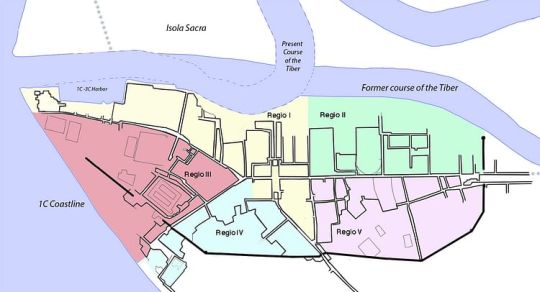
Ostia
Ostia (or Ostia Antica) lies 15 km from the city of Rome for which it served as the city's principal port and harbour throughout antiquity. The name derives from 'os' or 'ostium' which means 'mouth' and refers to the city's location at the mouth of the river Tiber. Although originally situated at the mouth of the river, because of silting, it is now some 3 km east of the present river mouth although still located on the south bank of the Tiber.
Early History
Ostia began its existence as a small settlement of native peoples in, perhaps, the 14th century BCE and was established in order to exploit the salt marshes to the immediate east. Roman tradition has it that Ostia was founded as a colony, Rome's first, by its fourth king, Ancus Marcius in the late 7th century BCE, a date supported by Livy who suggests a founding date around 620 BCE.
The strategic importance of Ostia for the defence of the Tiber mouth became apparent early on and it was fortified (the date is controversial, most probably in the mid 4th century BCE) with a military camp or castrum. This consolidated an advantageous position in Rome's continuing conflicts with pirates and with its neighbours and it played a major resupply role in the wars against Carthage. This castrum exerted a major influence on the subsequent layout of the city and the remains of its wall may be seen, inter alia (among other things), bordering the Piazza dei Lari to the east.
The Decumanus Maximus road divides the city north and south with the zones Regio I and Regio II to its north (and bordering the Tiber) and Regio IV and Regio V to its south. At the western border of the castrum the Decumanus Maximus encountered the old via della Foce road ('road of the mouth' also called the via Laurentina) which strikes it at an oblique angle running from northwest to southeast. The Decumanus for that reason was carried off not directly to the west but to the southwest. This creates a wedge-shaped section extending from the intersection of the Decumanus Maximus and the via Laurentina westward. This wedge is Regio III. In addition to the five regions there are two outlying constructions; an 'Imperial Palace' about 200 m distant to the west which is conceptually part of Regio I and the 'Porta Marina' or Sea Gate complex which is assigned to Regio III.
Continue reading...
34 notes
·
View notes
Text
Exploration of the now-offline Far Cry 5 official websites
Part 14: Jerome Jeffries
Recovered content
On the American website, Jerome was introduced on or before July 13th, 2017:

THE PASTOR JEROME JEFFRIES After serving in the Gulf War, Jerome returned to Montana to serve as the county’s Catholic parish priest. But with the influx of Project at Eden’s Gate, he lost his church and some blood along the way. Now, armed with the Good Book and a good gun, he’s ready to lead his congregation from the pulpit once again.
There was a link to this video:
youtube
In an article titled “Meet Far Cry 5's Characters” posted on May 26th, 2017, on the same website, this is what we could read about Jerome:
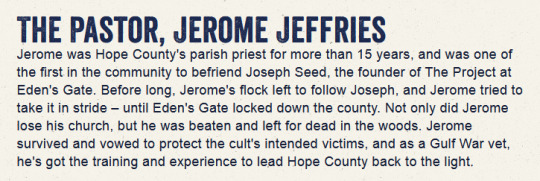
THE PASTOR, JEROME JEFFRIES Jerome was Hope County's parish priest for more than 15 years, and was one of the first in the community to befriend Joseph Seed, the founder of The Project at Eden's Gate. Before long, Jerome's flock left to follow Joseph, and Jerome tried to take it in stride – until Eden's Gate locked down the county. Not only did Jerome lose his church, but he was beaten and left for dead in the woods. Jerome survived and vowed to protect the cult's intended victims, and as a Gulf War vet, he's got the training and experience to lead Hope County back to the light.
On or before February 9th, 2018, on the page dedicated to the characters, his description was modified:

THE PASTOR JEROME JEFFRIES Pastor Jerome Jeffries is God’s hammer. He served in the first Gulf War and saw combat up close, then returned to Montana and has been the region’s pastor for over 15 years. When Joseph Seed arrived 10 years ago, Pastor Jerome Jeffries was one of the first to befriend him. It wasn’t long before many of the pastor’s congregation broke away and joined Joseph, calling him Father. Pastor Jerome Jeffries became uncomfortable with Joseph’s unorthodox worship, but conceded that people must choose their own path to God. Then came the lockdown. The Pastor was beaten, tossed in the woods, and left to die. He clawed his way back to life and headed back to Fall’s End to protect those in need with the Good Book in one hand and a gun in the other.
And on March 27th, 2018, while the text and the linked video remained the same, the presentation slightly changed:

On the European website, from March 10th, 2018 (or earlier), to at least February 7th, 2020, he was described as follows:

JEROME JEFFRIES THE PASTOR After serving in the Gulf War, Jerome returned to Montana to serve as the county’s Catholic parish priest. But with the influx of Project at Eden’s Gate, he lost his church and some blood along the way. Now, armed with the Good Book and a good gun, he’s ready to lead his congregation from the pulpit once again.
The video was the same as the American one, but uploaded on the Ubisoft UK YouTube channel:
youtube
Commentary
Jerome does say he once was “a pawn in an oil war” in Far Cry 5, and Mary May, that “he fought in Iraq one or two”, so the part about him serving in the first Gulf War (like Jacob) seems canon. Because of the (cut) description of the Lamb of God Church, I assumed he was Lutheran and not Catholic, so either I’m wrong or they changed their mind and that explains why the word “Catholic” then disappeared from the description.
He also talks about having been kidnapped by John, who managed to make him say things he’s apparently ashamed he said, then “beaten, tossed in the woods, and left to die”, after which he considered leaving but decided against it and to protect the people of Fall’s End instead when he found a copy of the Bible. Although that dialog is still in the game, it always bothered me in terms of the timeline because Jerome says the incident happened before the Deputy arrived, but the Reaping (so the cult locking down Hope County and capturing Fall’s End) only began after Joseph’s failed arrest...
As for the part about him befriending Joseph, it’s never mentioned in the game, but we can imagine Jerome did welcome the Seed family when they arrived. However, it’s reminiscent of the live-action trailer The Baptism, in which we also get a glimpse of Joseph dragging an unconscious Jerome. Several elements of the video, the most important and mysterious one being the little girl, were never explained and/or are inconsistent with the current story of Far Cry 5... but maybe not with early versions of it.
I don’t know how canon this description still is, but I think it’s yet another proof that the story in general and the cult’s methods in particular went through several changes during the development of the game and that, at one point, the locked-down county and the constant terror caused by Eden’s Gate were not new; they had been going on for weeks, maybe months or even years before the Deputy’s arrival, and Jerome had been fighting against them the whole time.
Under the cut are all the available source files, saved directly from the website, of the images you see in the screenshots:



44 notes
·
View notes
Text
LONG META , persephone's duties x persona, the goddess of elysium and reincarnation , the destroyer & the dreadful :

i just want to say that i do have a gripe with the common description of persephone being an only kind-hearted goddess full of life and usually described as 'the sunshine', 'the cinnamon roll''. i do believe her existence as mere 'kore' was definitely simpler, and that she mostly spent her time with the nimphs, satyrs and mortals, that she was a youthful being and less strict, wanting more in her natural need for fertility and grandness, lover of nature and life-bringer - but as the persephone the hyms describe her, the force behind the name and its meaning, while sympathetic to mortals and heroes and definitely benevolent on cases, was a very dangerous goddess the mortals mostly feared. she ruled not just the underworld, but the season that brought mortals, essentialy, life back. and if she was unpleased, then they would be too ; after her cult became strong in ancient greece, you have depictions of them fearing to say her name out loud, and vowing to kore spokenly instead - the hyms essentially placing her as a guiding force of death, not just life. she was also very ruthless to those two kept duties from being done, and was essentially described as awful and dreadful. she was written as terrible many times before;
Hesiod, Theogony 767 ff (trans. Evelyn-White) (Greek epic C8th or 7th B.C.) : "There, in front [of the ends of the earth], stand the echoing halls of the god of the lower-world, strong Haides, and of awful Persephone. A fearful hound [Kerberos (Cerberus)] guards the house in front . . . keeps watch and devours whomsoever he catches going out of the gates of strong Haides and awful Persephone."
Ovid, Heroides 21. 45 ff (trans. Showerman) (Roman poetry C1st B.C. to C1st A.D.) : "[A maiden laments the death of her lover :] Ah me, at the very time of marriage cruel Persephone knocks at my door before her day!" [N.B. Here Persephone is the personification of death.]
Orphic Hymn 57 to Chthonian Hermes (trans. Taylor) (Greek hymns C3rd B.C. to 2nd A.D.) : "[Hermes] who constant wanderest through the sacred seats where Haides' dread empress, Persephone, retreats; to wretched souls the leader of the way, when fate decrees, to regions void of day . . . for Persephone, through Tartaros dark and wide, gave thee for ever flowing souls to guide.
she's hardened, she's dutiful and feared for it. and while we do have many other tales of her being written as benelovent and the wise next to haides, i like to think she is both. all the time. she's nurturing because she brings forth life, but she's feared because she is one of the guides of death, she forbrings the thawn of ice but also, she is all of it within the concept of rotting and fading away and waiting for your final judgement, both raw and cruel as well as the one giving a second chance and an offer for rebirth:
Theognis, Fragment 1. 703 ff (trans. Gerber, Vol. Greek Elegiac) (Greek elegy C6th B.C.) : "Persephone who impairs the mind of mortals and brings them forgetfulness. No one else has ever contrived this, once death's dark cloud has enveloped him and he has come to the shadowy place of the dead and passed the black gates which hold back the souls of the dead, for all their protestations."
Pindar, Dirges Fragment 133 (trans. Sandys) (Greek lyric C5th B.C.) : "But, as for those from whom Persephone shall exact the penalty of their pristine woe, in the ninth year she once more restoreth their souls to the upper sun-light; and from these come into being august monarchs, and men who are swift in strength and supreme in wisdom; and, for all future time, men call them sainted heroes." [N.B. Pindar appears to be saying that the soul is judged in Hades and, if found guiltless, passes on to the realm of Elysium. It must, however, return to earth twice more and suffer two more deaths. Then, finally, Persephone releases it from the cycle--it returns to earth once more to live life as a righteous king, hero or sage, before being sent to the paradisial Islands of the Blest.]
Statius, Silvae 5. 1. 253 ff (trans. Mozley) (Roman poetry C1st A.D.) : "Whenever a shade approaches that has won the praise of a loving spouse, Proserpine [Persephone] bids summon joyful torches, and the heroines of old come forth from hallowed bowers and scatter the shades of gloom in radiant light, and strew garlands and Elysian flowers before her."
so there's this belief that persephone breaks the cicle and created reincarnation, which makes sense considering spring can be life ( and represents it, with a very dark-known myth i won't get into right now ). perhaps the mortals mostly feared not being worthy of it, and that her judgement would be unforgiving. but yes, this is the route i'm taking. maybe my persephone will be perceived as cruel by your muse at times, but she's doing what she considers righteous ; she's still a representative of death, after all, and it is never pleasurable to face it.
#AND THUS I INVOKE ╲ proserpine › about.#my ramblings begin....#i don't know if i made sense but this is basically me saying that uh#sometimes she will come off as difficult lol#but she's mostly well-intended if her hubris isn't so profoundly attacked (or the well being of someone she cares for especially)#on a side note#i love how she's described as a loving spouse#she is v loving#long post tw
6 notes
·
View notes
Text
"Your a fucking idiot!!"
"Do you think that it started with Hamas on Oct. 7th?"
"Holy shit!!"
"Deliberately targeting civilians and taking old people and children hostage"
You sure about that?
"Finally, it explains why army spokesperson, Daniel Hagari found that a "substantial" number of the hostages taken by Hamas are military officers." -Wsw.org (Referenced later also!!)
'Jewish militias organized several bombing attacks against civilians and military Arab targets. On 12 December 1947, the Irgun placed a car bomb opposite the Damascus Gate, the main entrance to the Old City of Jerusalem, killing 20 people.[19] On 4 January 1948, the Lehi detonated a lorry bomb against the headquarters of the paramilitary al-Najjada located in Jaffa's Town Hall, killing 15 Arabs and injuring 80.[19][20]'
'The next day, Irgun members in a stolen police van rolled a barrel bomb[22] into a large group of civilians who were waiting for a bus by the Jaffa Gate, killing 20.[23][24][25][26] Another Irgun bomb went off in the Ramla market on 18 February, killing 7 residents and injuring 45.[27] On 28 February, the Palmach organised a bombing attack against a garage in Haifa, killing 30 people.[28]'

Yeah. Israel did bad things.
More than Hamas EVER did.
"As of 5 March 2024, over 31,000 people (30,228 Palestinian and 1,410 Israeli) have been reported as killed in the Israel–Hamas war, including 94 journalists (89 Palestinian, 2 Israeli and 3 Lebanese) and over 136 UNRWA aid workers."
Look at THE FUCKING NUMBERS
". As the World Socialist Web Site has repeatedly warned, ever since his government took office at the end of 2022, Netanyahu has mounted provocation after provocation against the Palestinians aimed at inciting retaliation, as then occurred on October 7. Al-Aqsa Flood provided the casus belli for a pre-planned campaign of mass murder and ethnic cleansing of the Palestinians beginning with Gaza and then moving on to the West bank and including Israel’s two million Arab citizens."
"Many of the Israeli families of those killed, injured or taken hostage on October 7—reflecting a widely held view that Netanyahu is responsible for the disaster and did nothing to prevent it—have called for an independent and international investigation, which the government has refused. They have demanded answers to two basic questions:
What did Israel’s military-intelligence apparatus know in advance about what Hamas had planned?
And what actually happened over the weekend of October 7-8?"
"The authorities have not explained how Israel’s massive electronic border fence could have been breached with only rudimentary tools and without any sirens going off or army bases being alerted—with the result that the Middle East’s most sophisticated army took hours to arrive at the scene in a country no bigger than the US state of New Jersey."
"...and prevent the establishment of a mini-Palestinian state made up of the West Bank and Gaza."
"Just two days after the attack, on Monday October 9, Egypt exposed Netanyahu’s protestations that he had no foreknowledge. An Egyptian intelligence official told the Associated Press that Cairo had repeatedly warned the Israeli authorities that “something big” was being planned."
"Netanyahu has denied receiving any such warning, denouncing the story as “fake news.”
"Israel’s own soldiers also reportedly raised the alarm. But they were ignored and threatened."
"Put more bluntly, they wanted an atrocity and so stood down their defence and rescue services. Furthermore, the Biden administration’s full-throated support for Israel—including its deployment of warships to the region the very next day—indicates that October 7 was seized on by US military and intelligence officials to activate war plans prepared long in advance."
"Palestinian prisoners held in Israeli prisons—some 1,500 of whom were being held under administrative detention, without charge or trial, for an indefinite period."
"..which just five days earlier had been extended by one day to October 7."
"According to reports in the Israeli press, the IDF, “caught off guard,” were slow to respond to the desperate cries for help."
"377 military and police personnel and 845 civilians, for a downwardly revised total of 1,222. The initial total included some of the dead Palestinians.)"
"Some 1,500 Palestinians were reportedly killed, with none apparently captured alive. "
"IDF Apache helicopters were used repeatedly in the next days, killing not only Palestinian fighters, but also Israeli army personnel and civilians. The helicopter strikes explain the significant damage to buildings, with many burnt out, and the large number of burnt-out cars, as well as several burned bodies, which the government had blamed on Palestinians armed with rifles and hand grenades—weapons that are incapable of causing that level or type of damage."
"In the event, however, IDF soldiers fired not just on the Palestinians, but also on (Israeli) hostages."
"while several Israelis have claimed they were fired upon by Israeli military and police."
"Hamas could not have planned to attack it, as the festival organisers switched to the site in the Western Negev desert only two days before"
"IDF helicopter opened fire on the attackers, hitting some people attending the festival. ABC News had earlier reported that an Israeli tank had headed to the site of the festival, while videos appeared to show IDF forces opening fire at Palestinian fighters through a crowd of unarmed civilians."
"The IDF acted as brutal and trigger-happy mass murderers of both Palestinians and Israelis.
Many Israeli captives were still alive on the Monday, two days after the events of October 7.
Hostages were not only killed in the crossfire that took place between the IDF and Palestinian militia on the Saturday. Many were killed as a consequence of the IDF’s deliberate decision to attack the kibbutz with tank shells and other heavy weaponry at close quarters in the full knowledge that hostages and their captors were there.
The IDF, not the Palestinians, caused many of the Israeli civilian deaths that were used to justify Israel’s genocidal war on Gaza and the deployment of US warships to the Middle East. How many can only be confirmed by releasing the results of autopsies that would show the type of bullets used."
"Far from protecting Israeli civilians, the Netanyahu government and the IDF used them as cannon fodder in pursuit of a policy of Israeli expansionism and Jewish Supremacy."
"Netanyahu has, in part, agreed to a temporary “operational pause” in Israel’s genocidal assault on Gaza, in return for Hamas releasing 50 hostages, to try and contain mounting anger within Israel over his responsibility for October 7. But there is no reason to believe this will work."
"It is not a question, as Israel’s Zionist opposition to Netanyahu put it, of handing the reins to someone who is more militarily and politically “competent” to wage mass murder and ethnic cleansing, such as defence minister Gallant.
The demand must be for an immediate end to the genocide of the Palestinians, repudiating Zionism and advocating the creation of a multinational state with full equality for its Palestinian and Jewish citizens as part of a United Socialist States of the Middle East."
-https://www.wsws.org/en/articles/2023/11/23/buna-n23.html
0:30 -0:50 : 'On Oct. 17th, 2023, more than 500 people were killed in an Israeli air strike at Al Alhi Arab Hospital in Gaza city. [..] Independent Investigators and weapons experts analyzed videos and ultimately concluded that the Israeli military was responsible for the strike.'
0:52 - 1:07: "The Israeli military, that said they would never do such a thing as bomb a hospital, bombed and raided Gaza's largest hospital, Al Shifa, alleging that Hamas was operating a command centre in tunnels below the complex. A claim that was repeatedly denied by both Hamas and hospital administration."
1:11 - 1:12: "The Israeli military also shared a *fabricated* 3-D animation to reveal what the tunnels apparently looked like."
1:19 - 1:21: [..] "But since Israeli forces finally gained access to the hospital, the military has yet to provide concrete evidence of a subterranean Hamas command centre."
2:23: "The right to self defense applies to a state when it is attacked by another, and its national security and existence are exposed to danger. At that time, this state informs the United Nations first, and then uses for to defend itself. This does not apply to the current situation. (Gaza) - Shawan Jabareen."
2:30 -2:39:"[..] Israeli forces have intentionally targeted civillian areas, throught the enclave accusing all of Gaza's residents ((Yes. Including the children that were less than a few days old who were killed.)) of being 'aware' and 'involved' with Hamas."
2:58 - 3:05: 'Meaning, over 80% of Gaza's population to flee their homes and become displaced due it's relentless air strikes."
3:28- 3:32 'So that anyone critical of the Israeli State, or its actions is invariably and automatically charged with anti-Semitism.'
3:43-3:44: 'And to discourage Jews critical of Israel's inhumane and illegal activities from speaking up.'
(Sound familiar? Oh yeah. It does. https://encyclopedia.ushmm.org/content/en/timeline-event/holocaust/1942-1945/german-poster-announces-death-penalty-for-aiding-jews, "I remind you that according to the Third Decree of the General Governor's concerning the residential restrictions in the General Government of 10/15/1941 (VBL; abbreviation for Verordnungsblatt Generalgouvernement, p. 595) not only Jews who have left their designated residential area will be punished with death, but the same penalty applies to anyone who knowingly provides refuge to such Jews. This includes not only the providing of a night's lodging and food, but also any other aid, such as transporting them in vehicles of any sort, through the purchase of Jewish valuables, etc.")
3:50-3:57: "The Israeli military has used deadly weapons and ammunition including white phosphorus shells in its attack on Gaza. A clear violation of international law."
(Hey sound familiar? 'Munitions containing white phosphorus were used extensively in World War II' https://www.weaponslaw.org/weapons/white-phosphorus-munitions#:~:text=White%20phosphorus%20has%20been%20used,as%20an%20anti%2Dpersonnel%20weapon.)
4:25-4:50: 'Tel Aviv has been claiming that Palestinian civilians are being killed because Hamas is using them as human shields, however no evidence has been put forth to substantiate this claim and even international organizations have been unable to verify it. In fact, rights groups argue that the use of human shields is actually a 'common practice' employed by Israeli soldiers.'(Example is shown in video.)
4:57-5:06: 'Soon after ordering Palestinians in northern Gaza to move to the south, which it [IDF] assured would be a 'safe zone', Israel began bombing the southern region alleging that it was also a centre of Hamas activity.'
5:09-5:21: 'Israeli officals designated Al Mawasi in southern Gaza as a safe zone that would have acess to humanitarian aid. Yet what displaced Palestinians found, instead, was a desolate wasteland without any infastructure.'
5:27-5:43: 'Following the killing of Al Jazeera journalist, Same Abu Daqqa in Gaza, the Israeli army stated, on Dec. 16th, that 'it has never, and will never deliberately target journalists.' (Those guys are in bright blue, for a reason.) However, since Oct. 7th, Israel has killed at least 109 journalists in Gaza." (all of which were wearing the blue vest reading 'PRESS'.)
5:53: 'It [Israel] refers to Palestinian resistance groups, including Hamas, as 'terrorist' organizations. All while Tel Aviv itself faces accusations of war crimes and human rights violations.' (Wanna go to Telegram and see some of those? Yeah? Yeah? )
6:30-7:00: 'Following Hamas's attack on Israel, Israeli media had reported that the Palestinian group had killed at least 40 babies, quoting Israeli forces as the source of this information. [..] Said that babies and toddlers had been found with their 'heads decapitated'. But soon thereafter, international journalists and news agencies who had reported the stoy walked back on their reports. (USA Today, New York Post, CNN, CBS News Miami.) and Israeli officals say that they could not confirm that any babies had been beheaded.'
-https://www.trtworld.com/video/digital/gaza-lies-israel-fed-the-world-since-october-7-16627251
Shut the fuck up. Do your research before talking. Thanks.

Holy shit
#free palestine#free gaza#palestine#pipssomehowhere#current events#israel#gaza#jerusalem#gaza strip#from the river to the sea palestine will be free#debate#ethics#critical thinking#morality#morals#society#you're a fucking idiot#Israel#genocide#unrwa#hamas#research#gaza genocide#ethnic cleansing#flour massacre#al shifa hospital#war crimes
44K notes
·
View notes
Text
Learn History at Chittorgarh Fort

Chittorgarh Fort is one of the most famous historical landmarks in Rajasthan, India. It stands as a symbol of bravery, sacrifice, and rich history. Visiting Chittorgarh Fort is not just about seeing ancient architecture but also about learning the stories of warriors, kings, and queens who shaped the region. If you're someone interested in history and culture, a trip to this fort is an excellent way to immerse yourself in the past. For those planning a visit to this grand site, working with a reliable travel agency in Rajasthan can make your trip even more memorable.
The fort, which is situated in Chittorgarh, is one of the largest forts in India and is considered a UNESCO World Heritage site. The fort's massive structure includes numerous palaces, temples, and towers, each with its own story. To truly appreciate the fort’s significance, it’s important to understand the history behind its walls.
The Importance of Chittorgarh Fort in History
Chittorgarh Fort has a rich and deep history that spans many centuries. It was originally built in the 7th century by the Maurya dynasty and has since witnessed numerous battles, royal sieges, and moments of glory. It was once the capital of Mewar and served as a crucial defense against invaders. The fort’s walls, which stretch over 13 kilometers, have seen both triumphs and tragedies. Among its most famous stories is the sacrifice of Rani Padmini and the brave defense put up by the Rajputs during the invasions of the Delhi Sultanate.
For history enthusiasts, visiting Chittorgarh Fort is a fascinating journey through time. Whether it’s the tales of valor or the architectural wonders, there is something for everyone. A tour operator in Rajasthan can offer guided tours to help you understand the deeper meanings behind every monument within the fort.
The Structures Within the Fort
One of the most remarkable aspects of Chittorgarh Fort is its vast array of structures that reflect the grandeur of Rajasthan’s royal past. The fort houses several palaces, including the famous Padmini’s Palace, where Rani Padmini, the legendary queen, is said to have committed Jauhar (self-immolation) to protect her honor. The Kirti Stambh (Tower of Fame) is another significant structure, dedicated to the Jain Tirthankara Adinatha. It stands tall at about 22 meters and offers a beautiful view of the fort and the surrounding landscape.
Another key feature of the fort is the Vijay Stambh (Tower of Victory), built to commemorate Rana Kumbha’s victory over the combined forces of Malwa and Gujarat. This tower is one of the most iconic monuments in Rajasthan, standing at an impressive height of 37 meters.
As you explore these structures, you’ll come across temples, baoris (step-wells), and gates, each telling stories of the region's culture and traditions. These sites make Chittorgarh Fort a treasure trove for those looking to learn about history.
The Siege of Chittorgarh
The fort has faced multiple sieges throughout its history, but the most famous ones were by the forces of Alauddin Khilji and later by Emperor Akbar. The siege led by Alauddin Khilji in 1303 was one of the most significant events in the history of Chittorgarh. He laid siege to the fort for several months, and despite the valiant defense put up by the Rajputs, the fort eventually fell. It is said that during this time, Rani Padmini, along with other women of the fort, performed Jauhar to protect their honor from the invaders.
Later, in the 16th century, during the reign of Emperor Akbar, the fort faced another siege, though this time the Rajputs were unable to withstand the Mughal forces. These events made Chittorgarh Fort a symbol of sacrifice, courage, and resistance against foreign invaders. Visiting the fort with a travel agency in Rajasthan can give you a deeper understanding of these historical events and help you connect with the stories that shaped the region.
Exploring Chittorgarh Fort Today
Today, Chittorgarh Fort remains a vital tourist destination. The fort is open to visitors from all over the world who come to witness its grandeur and learn about its fascinating history. A guided tour through the fort can help you learn about the many rulers who once lived here and the events that shaped the area. You will also find several plaques and inscriptions that provide further details about the fort’s history.
Many tourists choose to visit the fort through a travel agency in Rajasthan, which makes the experience more enriching. These agencies offer organized tours, which often include transportation, guides, and other services that help you get the most out of your trip. A professional tour operator in Rajasthan can ensure that your visit to the fort is not only educational but also convenient and comfortable.
Cultural Significance of Chittorgarh Fort
Chittorgarh Fort is not only an architectural wonder but also a cultural hub. Over the centuries, it has hosted various royal events, festivals, and gatherings. The art and culture of the Rajput era are beautifully reflected in the fort’s carvings, paintings, and sculptures. These pieces of art offer a glimpse into the lives of the royals who once lived here and provide valuable insights into the rich cultural heritage of Rajasthan.
Visitors often spend hours exploring the fort, admiring the craftsmanship and the detailed artwork that adorns its walls. Whether you’re interested in history, architecture, or art, there’s plenty to explore and learn. By booking a tour with a tour operator in Rajasthan, you can enjoy an informative and well-planned visit to this iconic site.
Tips for Visiting Chittorgarh Fort
If you're planning a trip to Chittorgarh Fort, there are a few things you should keep in mind to make the most of your visit. First, it’s advisable to visit the fort early in the morning to avoid the midday heat, especially during the summer months. Wearing comfortable shoes is also important, as you will be walking for several hours on uneven terrain. You should also carry water and snacks, as the fort is quite large and exploring it can be exhausting.
For those who wish to learn in-depth about the fort’s history, it’s best to hire a local guide. A knowledgeable guide can provide a detailed explanation of the fort’s significance, making your visit much more informative.
Conclusion
Chittorgarh Fort is a must-visit for anyone interested in Rajasthan’s history. It is a place where history comes alive, from its ancient structures to the legends of bravery and sacrifice that it holds. Whether you are fascinated by the Rajput rulers, the architectural marvels, or the stories of battles and sieges, Chittorgarh Fort has something to offer every history lover.
For a seamless experience, consider booking your visit through a reliable travel agency in Rajasthan. A good tour operator in Rajasthan will ensure that your trip is well-organized, educational, and enjoyable. With their expertise, you can explore the fort at your own pace and make the most of your time at this historical gem.
0 notes
Text
Things to do in Tadoba Andhari Tiger Reserve
Tadoba Andhari Tiger Reserve is situated in the district of Chandrapur in the state Maharashtra of India which is famous wildlife spot of tigers and the asylum of biological diversification. If you're planning a trip, here are some exciting things to do:
Top Things to do in Tadoba
1. Jungle Safari
Experience the Thrill of Wildlife: Tiger spotting is especially loved by tourists in Tadoba. Choose jeep safari or canter safari an open bus which covers the core as well as the buffer areas of the park.
Best Zones for Safari: KDD is divided into zone-wise six tourism zones out of which Moharli, Kolsa and Tadoba are well-known for sighting wild animals. There are transitory appearances of tigers regularly at Moharli zone.
Animals to Spot: In addition to the tigers, you can expect to see leopards, sloth bears, wild dogs (Dholes), Gaur (Indian Bison), Sambar deer, spotted deer and many birds.
2. Nature trail and Bird watching
Enjoy Nature's Serenity: There is more to see at Tadoba National Park than just tigers and other big cats. This park contains over 195 bird species and varieties such as water birds, eagles, owls and migratory birds.
Bird Watching: A nature trail/ bird watching trip around the lake and bamboos forests provides the visitor with an excellent view of the birds in the park.
3. Visit Tadoba Lake
Scenic Beauty: Tadoba lake located inside the core area is an excellent point for relaxation and to have a close look at the wild life.
Photography: This area is perfect for photography as the animals will come out in their natural instinct during sunrise and in the evening. Tigers, crocodiles and birds can be seen in and around the lake region.
4. Stay at Jungle Resorts
Experience Wilderness: Some of the common jungle resorts near this reserve are many and there are many eco-lodges located in this reserve where one can comfortably sleep. These can be simple cabins with a log cabin feeling but with every conceivable luxury.
Night Safaris and Campfires: They can as well organize for night viewing in the buffer areas so that one can be able to view the wild at night too.
5. Visit Local Villages
Cultural Experience: This project should try to involve the local tribal population such as the Gond and Kolam tribes. Find out more about their customs, beliefs and a daily lifestyle associated with the forest.
Handicrafts and Souvenirs: Shop for local artifacts, especially crafted by the tribes.
6. Photography Tours
Wildlife Photography: The photo safari in particular is great at Tadoba. That way, regardless of whether you are a professional or just an occasional tourist, there could hardly be a better place to visit as the wildlife here teems with terrific tigers and colorful birds besides breathtaking vies of sceneries.
Best Time for Photography: There is nothing as beautiful as taking a photography session at the break of dawn and at the dusk.
7. Ancient Tadoba Temple
Said to have been build around the 7th century, this temple, built in honour of Tadoba, an associated deity of the region is located on the periphery of Tadoba Lake and can be explored with respect to spirituality and traditions.
8. Explore the Buffer Zone
The places like Agarzari and Devada are comparatively less crowded as compared to areas near the park and the authorities also encourage wildlife tourism and you can spot lion, tiger, leopard etc.
9. Boating and Lake Safari tour at Irai Lake
Peaceful Boating: About 30 Kms from Tadoba there is a beautiful place Irai Lake to enjoy boating amidst natural surrounding. You can pass a time here and watch other animals being drawn to come to water for water.
Wildlife Viewing: Wildlife while at the lake safari may be occasioned to see crocodiles, birds and occasionally other wild creatures along the shores of the lake.
10. Explore Tadoba Museum
There is an information centre present at the Entry gate of the museum, which provides information regarding the park, the wildlife, the forest found in the region and the measures taken to preserve wildlife.
Travel Tips for Tadoba:
Best Time to Visit: October to March is perfect for Wildlife watching and good climate prevails.
Booking in Advance: Buy safari tickets through online booking to avoid the crowd.
Carry Essentials: Apart from the essential items, while going on a safari, you should always carry sunglasses, hat, binoculars, camera, bottle and water with you.
Tadoba Andhari Tiger Reserve offers a wonderful opportunity to observe jungle and wildlife, nature and history, wildlife and culture.
#travel#tour#india#india travel#tadoba#tadoba national park#tadoba tiger reserve#tadoba reserve#india tour#india tourism
0 notes
Text
Introduction to the Eastern Yi (HHS085)
[The commentary by Li Xian in italics (slightly abbreviated)]
The Royal Regulations states: “The people in the eastern regions are called Yi.” Yi means roots. It tells they are humane and fond of life. The ten thousand things take root in the ground and then spring forth. For that reason, their Heaven-given nature is gentle and compliant, and they are easily steered by the Way, extending to the states of noble lords and the undying.
The Classic of Mountains and Seas says: In the state of noble lords they have clothes, caps, belts and swords. They eat beasts and make two patterned tigers be at their sides.
The Chart of the Outer States says: The distance to Langye is 30 000 li.
The Classic of Mountains and Seas also says: The undying people are east of Jiaojing. They have people who are black in colour, whose lifespans does not die.
The Yi have nine kinds
The Bamboo Annals says: 3rd Year of Hou Fen's reign, the Nine Yi, came to be steered.
These are called: the Quan Yi, the Yu Yi, the Fang Yi, the Yellow Yi, the White Yi, the Red Yi, Xuan Yi, the Fang Yi, and the Yang Yi. For that reason Master Kong wished to live among the Nine Yi.
The Bamboo Annals says: 21st Year of Hou Xie, instructed the Quan Yi, the White Yi, the Red Yi, the Xuan Yi, the Feng Yi, and the Yang Yi. 2nd Year of Hou Xiang's reign, campaigned against the Yellow Yi. 7th Year, the Yu Yi came to visit. After Shaokang was enthroned, the Fang Yi came to visit.
Formerly Yao instructed Xizhong to dwell among the Yu# Yi, where it was called Sunrise Valley, which presumably is where the sun sets out from.
Kong Angu's Commentary to the Hallowed Documents says: The lands of the eastern region was called Yu# Yi. Sunrise Valley is where the sun sets out from.
Taikang of the Xiahou clan lost the virtue, and the people of the Yi started to rebel.
Taikang was the son of Qin. He was absorbed in the roaming hunt, and in ten ten-days did not turn around. He did not have compassion for people's affairs, and was expelled by Yi.
From Shaokang and afterwards, they for generations submitted to the King's persuasions and thereupon visited at the King's gate to present their music and dance.
Shaokang was the grandson of Emperor Zhongkang and the son of Emperor Xiang.
The Bamboo Annals says: 1st Year of Hou Fa's reign, the various Yi visited at the King's gate. The various Yi entered to dance.
Jie was brutal and cruel, and the various Yi invaded the interior. Tang of Yin deprived him of the instructions, he attacked, and settled them. Arriving at Zhongding, the Lan Yi became bandits.
Zhongding was the son of Dawu of Yin.
The Bamboo Annals says: Zhongding was enthroned, he campaigned against the Lan Yi.
From that point, they sometimes submitted and sometimes rebelled, for about three hundred year. During the decline and deteriorations of Wuyi, the Eastern Yi were very abundant. Consequently they divided up and moved to the Huai and Dai regions, and gradually came to live in the central lands.
Wuyi was the son of Emperor Kangding. He had not the Way. He made a leather bag filled with blood, looked up and shot at it, instructing it be called “Shooting at Heaven”.
When King Wu wiped out Zhou# [of Yin], the Sushen came to present stone arrows and thorn-tree arrows. When Guan and Cai rebelled against Zhou, they therefore summoned and coaxed the Yi and Di. The Duke of Zhou campaigned against them, and thereupon settled the Eastern Yi.
In the Hallowed Documents, at the collapse of King Wu, the Three Overseers and the Huai Yi rebelled. The Duke of Zhou campaigned against them, and made the Great Announcement. It also says that when King Cheng had struck Guanshu and Caishu, he wiped out the Huai Yi.
In the time of King Kang, the Sushen again arrived. Later the Xu Yi usurped the title, and led the Nine Yi to strike at Honoured Zhou, to the west reaching the side of the He. King Mu dreaded their region's illustriousness, and therefore allotted the eastern region to the various marquises, and instructed the Supine [yan] King of Xu to be the ruler over it.
The Treatise on Broad Things says: A palace woman of the Lord of Xu became pregnant and gave birth to an egg. She considered it to be inauspicious, and abandoned it at the river bank. An alone and solitary woman had a dog named Hucang, which obtained the abandoned egg and returned back to the woman with it in its mouth. The woman covered and warmed it, and it then developed into a small boy. At birth he was yet at supine, and for that reason they used it as his name. The palace woman heard of it, and then once more took him back. He grew up to inherit as Lord of Xu.
Master Shi says: The Supine King had muscles but no bones, and for that reason he was named Supine.
The Supine King was located east of the Deep Pool, his territory was five hundred li square. He cted humanely and right-principled, Those with land and territory but at [his] court were thirty six states.
The Commentary to the Water Classic says: Huang River, also named Wang River, combines with Pao River. Arriving at Pei, it enters the Si. Eastward from Shanyang and northward from Hailing was where his territory was.
King Mu later obtained the carriages with thoroughbred steeds, and therefore sent Zaofu as steersman to make an announcement to Chu, ordering them to strike Xu, arriving there in a single day.
The Historical Records says: Zaofu, due to being a good steersman, found favour with King Mu of Zhou. He obtained the four horse team of Chiji, Daoli, Hualiu, and Lu'er, went west to patrol and hunt, was happy and neglected to turn back.
[Zaofu was an ancestor of the lords of Qin.]
Hence King Wen of Chu raised troops and wiped them out. The Supine King was humane but had no authority, and could not bear to struggle with his people, which caused his defeat. He therefore fled north to feet of the eastern mountains in Wuyuan county. Those of the hundred families who accompanied him numbered in the ten thousands, and following that they named his mountain as Xu Mountain.
The Treatise on Broad Things says: The King of Xu's unnatural peculiarities were not ordinary. Ten li east of Wuyuan county, he saw there was a Xu Mountain with a sacrificial place in a stone cave. The Supine King dug a ditch to communicate with area of Chen and Cai, and obtained a vermilion bow and a vermilion arrow. He considering that he himself had obtained a Heavenly omen, and declared himself the Supine King. King Mu heard of it, and dispatched an envoy in a carriage with four horses. After a single day he arrived in Chu, and they struck him. The Supine King was humane and could not endure to struggle. He was defeated by Chu, and fled north to this mountain.
[Note that King Mu of Zhou lived in the mid-10th Century BC, while King Wen of Chu reigned from 689 to 677 BC]
King Li [of Zhou, r. 877 – 841 BC] had not the Way and the Huai Yi entered to rob. The King instructed Guozhong to campaign against them. He had not advantage. King Xuan [r. 827 – 782 BC] then instructed the Duke of Shao to strike and pacify them.
The Preface to the Mao Poetry says: In Jiang-Han, Yin Jifu praises King Xuan. He was able to foster during a [period of] decline and fling off chaos. He instructed the Duke of Shao to pacify the Huai Yi.
Its poem says: The Jiang and Han float and drift. Martial men surge and swell. No settling down and no roaming. The Huai Yi have come probing. The King instructs Shao Hu: Apply the law to the four regions. All the way to our land's borders.
Reaching King You's [r. 781 – 771 BC] debauched chaos, the Four Yi invaded in succession. Arriving at Huan of Qi [685 – 643 BC], cultivating hegemony, he repelled and breached them. When Ling of Chu [540 – 529 BC] held a meeting at Shen [in 538 BC], they also came to participate in the covenant.
In the Zuo Transmittal, King Ling of Chu, the Marquis of Cai, the Marquis of Chen, the Earl of Zheng, the Baron of Xu, and the Huai Yi met at Shen.
Later the Yue moved to Langye, they campaigned against and fought together. Thereupon they infringed on and bullied the various Xia, and invaded and wiped out small nations.
Qin annexed the Six States, and their Huai and Si Yi were all dispersed to become people registered in households. When Chen She rose up with troops and Under Heaven collapsed and broke up, a native of Yan, Wei Man, escaped to the land of Chaoxian, and following that became king of their state.
The Book of Han says: The King of Chaoxian, Man, was a native of Yan. Since starting in the time when Yan was intact, he once captured what belonged to Zhenfan and Chaoxian, and set up magistrates and build redoubts. When Han rose, it belonged to Yan. The King of Yan, Lu Wan, rebelled and joined the Xiongnu. Man became fugitive from the authorities and fled east. He crossed the Pei River, and stayed on Qin's old desreted ground. He gradually made servants and dependants of the Man and Yi of Chaoxian, and those who had absconded from old Yan and Qi. He became king over them, and set his seat at Wangxian.
After more than a hundred years, Emperor Wu wiped them out, and so the Eastern Yi started to communicate with the Imperial Capital. When Wang Mang usurped the throne, the Mo people robbed the border.
In the Book of Han, Mang sent out troop from Gaogouli to attack the Hu, but they did not wish to go. The commanderies and counties forcibly compelled them, and they all absconded and set out for the frontier. Following that, they broke the law and became robbers. The province and commanderies resorted to blaming the Marquis of Gaogouli, Zou. Yan You memorialsed that the Mo people were breaking the law, it had not risen from Zou, and they ought to console and calm them.
1 note
·
View note
Text
Discover Your Dream Home at Aashrithaa Properties: Premier Real Estate on Mysore Road
Nestled in the heart of Bangalore, Aashrithaa Properties emerges as a distinguished name in the real estate landscape. As reputable builders and developers, the company has carved a niche for itself, especially on Mysore Road, offering a range of sought-after properties that include BDA Sites, BMRDA Approved Sites, and exquisite Gated Community Plots for sale.
BDA Sites on Mysore Road: Unparalleled Investment Opportunities
Aashrithaa Properties takes pride in presenting an exclusive collection of BDA Sites on Mysore Road, representing unparalleled investment opportunities for discerning buyers. These sites not only boast strategic locations but also align with the highest standards set by the Bangalore Development Authority (BDA). Investing in a BDA Site with Aashrithaa ensures a secure and promising future for homeowners and investors alike.
BMRDA Approved Sites on Mysore Road: A Testament to Quality
For those who prioritize quality and regulatory compliance, Aashrithaa Properties offers BMRDA Approved Sites on Mysore Road. These sites adhere to the rigorous standards set by the Bangalore Metropolitan Region Development Authority (BMRDA), ensuring that your investment is not just a purchase but a testament to uncompromising quality and legality.
Gated Community Plots for Sale in Mysore Road: Your Oasis of Tranquility
Imagine living in a secure enclave surrounded by lush landscapes and modern amenities. Aashrithaa Properties turns this dream into reality with its gated community Plots for sale in Mysore Road. These meticulously planned communities offer not just plots, but a lifestyle of unparalleled comfort and security. Experience the joy of residing in a thriving neighborhood where every detail is carefully crafted for your convenience.
Vijayashree Enclave: A Symphony of Elegance
One of Aashrithaa Properties' flagship offerings is the Vijayashree Enclave, a testament to the company's commitment to creating living spaces that redefine elegance. This premium development on Mysore Road showcases Gated Community Plots, each thoughtfully designed to provide residents with a harmonious blend of nature and modern conveniences. The enchanting atmosphere of Vijayashree Enclave makes it a prime choice for those seeking a sophisticated lifestyle in Bangalore.
Invest with Confidence: Aashrithaa Properties' Commitment
Aashrithaa Properties understands that investing in real estate is a significant decision. That's why the company prioritizes transparency, customer satisfaction, and a commitment to delivering projects on time. Whether you are eyeing BDA Sites, BMRDA Approved Sites, or Gated Community Plots in Mysore Road, Aashrithaa ensures that your investment journey is smooth, secure, and fulfilling.
In the dynamic real estate landscape of Bangalore, Aashrithaa Properties stands out as a reliable and visionary builder and developer. With a focus on BDA Sites, BMRDA Approved Sites, and Gated Community Plots for sale on Mysore Road, the company offers a diverse range of options for individuals seeking the perfect place to call home. Explore the elegance of Vijayashree Enclave and discover a world of possibilities with Aashrithaa Properties, where your dream home becomes a reality.
For more information :
Visit: https://aashrithaa.com/
Address
Aashrithaa Properties Pvt Ltd
#785/10, 2nd Floor, 14th cross, Krishna Rajendra Rd, above Adlabs, 7th Blocks,
Jayanagar, Bengaluru, Karnataka 560082
E-mail - [email protected]: +91 767688 9999
#aashrithaaproperties#vijayashreeenclavelocation#vijayashreeenclavemysoreroad#vijayashreeenclave#vijayashreeenclaveprice
0 notes
Text
Things to do in September Around the Area

September in our area is the perfect time of the year to enjoy outdoor events. The weather tends to be mild with the emergence of early autumn. Fall festivals are full of farmers’ and vintners’ agricultural offerings, as well as artists’ and musicians’ creative works. Take a look at this sampling of experiences in the D.C., Maryland, Virginia, and West Virginia area.
DC JazzFest
Aug. 30 through Sept. 3 The Wharf 1001 7th Street SW Washington, DC
Originally dubbed the Duke Ellington Jazz Festival in 2005, the DC Jazz Festival features acclaimed and emerging artists and provides a rich education component for young and old alike. The festival presents free and affordably-priced performances and education programs serving a diverse populace.
Patsy Cline Block Party
Sept. 2 Patsy Cline Historic House 608 South Kent St. Winchester, VA
Celebrate Patsy Cline’s birthday in her hometown with live music, tours of her childhood home, food, and educational exhibits. The Patsy Cline Historic House stands as an icon for Patsy Cline fans and admirers hoping to know first hand the story of Patsy’s early years and offering insight into the famed singer’s early road to stardom. Parking and free shuttle rides are available from the Winchester-Frederick County Visitor Center on 1400 S. Pleasant Valley Road and will run continuously throughout the day.
Virginia Scottish Games
Sept. 2 through Sept. 3 Great Meadow 5089 Old Tavern Road The Plains, VA
Experience the sounds and influences of Scotland through live music, dance, and athletic competitions at the 49th Virginia Scottish Games. Eat haggis, meat pies, Scotch eggs, and drink whisky. Research your own Scottish roots by meeting other folks with Scottish heritage.
Labor Day Art Show
Sept. 2 through Sept. 4 Glen Echo Park 7300 MacArthur Blvd. Glen Echo, MD
Presented by the Glen Echo Park Partnership for Arts and Culture, this exhibition and sale is one of the largest art shows in the area. Admission is free, and the exhibition features the work of more than 200 artists from the mid-Atlantic region. The wide range of artistic media includes sculpture, painting, ceramics, glass, jewelry, fiber arts, photography, furniture, and works on paper.
Maryland Cider Festival
Sept. 9 Two Story Chimney Ciderworks 115 Damascus Road Gaithersburg, MD
Drink apples, listen to music, eat food, and visit craft vendors. The Maryland Cider Festival will feature ten local cideries showcasing their best hard ciders – some dry, some sweet, still or sparkling, modern to heritage. It will be a great way to enjoy a fall day.
The Great Frederick Fair
Sept. 15 through Sept. 23 Frederick Fairgrounds 797 E. Patrick St. Frederick, MD
“Cowboy Boots and Down Home Roots” – The Great Frederick Fair’s celebration of agriculture is unmatched. Gate admission includes tons to see and do for kids and grownups: a cowboy circus, a farm animal birthing center, comedy shows, traditional agriculture exhibits, musical acts, magic, and more. Carnival rides and games will also be available with the purchase of a wristband or individual tickets.
Wild Roots Music Festival
Sept. 16 Wilderness Presidential Resort 9220 Plank Rd. Spotsylvania, VA
Located just west of Fredericksburg, the Wilderness Presidential Resort is hosting the Wild Roots Music Festival featuring regionally and nationally known bands and musicians. Family friendly music, games, and vendors will keep every generation entertained in a spectacular lakeside setting.
Bluemont Fair
Sept. 16 through Sept. 17 33846 Snickersville Turnpike Bluemont, VA
Meander through the 200-year-old village of Bluemont nestled in the foothills of the Blue Ridge Mountains. The 53rd annual Bluemont Fair features artisan crafts, local wine, beer, and music. Experience the history of the area including an archaeology demonstration. Children under 9 are free and can enjoy games and a petting zoo.
Mountain Heritage Arts and Crafts Festival
Sept. 22 through Sept. 24 Jefferson County Fairgrounds 1707 Old Leetown Pike Kearneysville, WV
Wander through the tents, buildings, and pavilions in the rolling countryside of Jefferson County, W.Va., and admire the crafts and fine arts of approximately 180 quality juried artists/crafters from over 20 states who will demonstrate their creative works. Bluegrass bands, kids activities, craft beer and local wine, food trucks, and more.
Apple Festival
Sept. 30 Loudoun Heritage Farm Museum 21668 Heritage Farm Lane Sterling, VA
Watch how cider is pressed and enjoy hard cider, beer, and wine. Kids will have fun with apple games and a moon bounce. What else? Live music and food trucks.
Manassas Latino Festival
Sept. 30 9201 Center St. Manassas, VA
This annual event has live music, dance performances, diverse foods, and fun activities for the entire family, all in celebration of the cultural heritage and contributions of the Latin American community. The Manassas Latino Festival is a project of Abriendo Puertas, whose mission is to empower the Latino community to integrate, thrive, and fully participate in building a stronger, just and inclusive society for all.
#jamierichards#realtorjamier#realtor#realestate#realestateagent#realestatetips#september#things to do#things to do in september#dmv#things to do in dmv#dmv activities#september activites
1 note
·
View note
Text
Goethe's Letter, 1787
Three thousand years ago, when the island was still heavily contested, the elephants came. Stormy winds attend [them]; the gift is given [them] of walking on the sea as the steeds in the aaskereia skim over tho wave. [Grimm, Teutonic Mythology The Complete Work] They took the long way from Africa across the sea to Sicily, because they heard that here were the oldest laimun tree with the most delicious fruit. This tree is seventeen feet in diameter. [Michelet, The History of France Vol 1] And it was said that whoever tastes a laimun once becomes wise and has a long life.
An elephant then has a special experience with a laimun. The tree cried, “Shake me! [Grimm, Fairy Tales] And the fruits fell off... The elephant picked up a lemon and took a bite. And from that first bite, he was able to see into the future. The general vibration that it produces in the whole [laimun] tree, [...] [Bichat, General Anatomy Applied to Physiology and Medicine Vol 1] makes the tree a sacred place. In front of the elephant’s eyes appears the story that I will experience 1500 years later in this very place.
We got off our ship and in front of us – the city – Palermo! You know [...] what is happening at Palermo[?] [Marx, Collected Works]
Through the wonderful gate consisting of two enormous pillars, [...], we were led into the city and immediately left into a large hotel [“The Intercontinental”]. The proprietor, a comfortable old man [named Orlando] who had always been used to seeing strangers of all nations, led us into a large room from whose balcony we could look out over the sea and the roadstead, the Rosalia Hill and the shore, and also see our ship and judge our first position. [Goethe, April 2nd 1787]
In the public garden directly at the roadstead, I spent the most pleasurable hours in silence. It is the most wonderful place in the world. Regularly laid out, it seems fairy-like to us; planted not so long ago, it takes us back to antiquity. Green borders enclose foreign plants, lemon trellises arch up to the cute foliage, high walls of oleander, adorned with a thousand red carnation-like blossoms, tempt the eye. Trees completely unknown to me, still without foliage, probably from warmer regions, spread strange branches. [...] But what gave the ensemble its most wondrous grace was a strong fragrance that spread uniformly over everything... [Goethe, April 7th 1787]
Since we must now threaten ourselves with an imminent departure from this paradise, I hoped to find a perfect refreshment in the public garden today. [Goethe, April 16th 1787]
A little of this lemon juice ... This should make it possible to look into the future. However, there are only a few hundred bottles left. Just a few people know where they are stored. The fear of running out of these Laimuncello bottles is too big.
Johann Wolfgang von Goethe Palermo, April 1787
0 notes
Text
Dubrovnik Uncovered - A Journey of Discovery Through History and Beauty
Dubrovnik has a wealth of history, from the 7th century through the Yugoslav Wars, there's a endless amount of interesting facts to learn about. The city has become one of the top destinations to go on GOT tours due to the Game of Thrones hype. There were many scenes filmed in this region. The Rector's Palace is a museum of culture and historic museum that has a beautiful courtyard. From here, you may enjoy the city walls, and look out over the Large Onofrio Fountain. St Blaise Church The Church of St Blaise is situated in Luza Square, at the eastern end of Stradun - Dubrovnik's main thoroughfare. The church is dedicated to saint Blaise who was a Christian martyr and bishop. There aren't many details about the life of the saint but he was among of the most famous saints in the Middle Ages. In Dubrovnik he is called Sveti Vlaho and the feast day for him is on the 3rd of February. He is considered the protector of Dubrovnik. his image is carved in stone, above all of the Dubrovnik gates, as well as on its official seals and coinage. The church was built during the 14th century, in a Romanesque style However, it was reconstructed in 1715, in the extravagant Baroque style of local constructors following an earthquake that devastated the area. The interior has a massive silver and gold-plated statue of the patron saint who was made in one of Dubrovnik's famous workshops in the 15th century. Cathedral of the Assumption of the Virgin Mary While walking through the walls of Dubrovnik you will be transported back to the past. In this excursion your guide will highlight the essential role that these imposing structures played in protecting the city's residents and ensuring its prosperity. Discover why sites such as the Revelin Fortress, Minceta Tower, as well as Lovrijenac Fortress were so crucial in this endeavor. Start your tour from Pile Gate. Explore the magnificent Franciscan Monastery, Orlando's Column and Rector's Palace. All while learning about the city's rich past from your guide. It's also possible to visit the Cathedral of the Assumption of the Virgin Mary The church is dedicated to the assumption of Mary into Heaven. It's a belief that was a source of controversy in early Christianity due to the fact that it disregarded the body of the saint and promoted ecclesial unity.
youtube
After that, you'll be able to see sweeping perspectives of Dubrovnik from the summit of the Minceta Tower. You'll also spot some famous shooting locations from the hit HBO series Game of Thrones. City Walls Take in breathtaking views and old treasures on this comprehensive tour through Dubrovnik's Old Town. Stroll the city walls with a guide and listen to captivating stories while passing landmarks like the Outer and Inner Ploce Gates. Admire the spectacular views of the Adriatic Sea and the terracotta colored rooftops as you stroll around the 13th century walls. Your guide will explain their significance and importance in this UNESCO World Heritage listed city. Also, you can visit the lavish Rector's Palace, built in the 15th century to experience the life of the aristocratic class. Discover why this city earned its UNESCO World Heritage listing on this guided walking tour. Explore 2,000-meters of pristine stones with your guide. Also, snap pictures of landmarks like Large Onofrio's Fountain, Orlando's Column and Lovrijenac Fortress. It's the best opportunity to explore the best of the city's sights and get a better knowledge of how this influential port grew into one of Europe's richest maritime republics. Dubrovnik Museum Dubrovnik Museum is a remarkable mixture of Gothic and Renaissance. Its restored Rector's Palace is the city's museum of culture and history. Visit the Rector's residence as well as the courtroom and ground-level dungeon to see what the city was like in earlier times. The museum also contains the collection of ancient artifacts which show the city's function as a merchant center and a rival to Venice in shipping and trade. Visit the Natural History Museum in Dubrovnik to experience a different perspective from history. The exhibits here include a 100-year-old taxidermy specimen of Freddie Mercury and an algae herbarium. The museum also houses a assortment of local flora wildlife and other interesting objects. https://www.youtube.com/watch?v=rCaUSNDUYH8
0 notes
Text
Exploration of the now-offline Far Cry 5 official websites
Part 3: Game Info 2 (America)
Recovered content
On July 13th, 2017, this is what the Overview, on the Game Info page of the American website, said:

OVERVIEW Welcome to Hope County, Montana, land of the free and the brave, but also home to a fanatical doomsday cult known as The Project at Eden’s Gate that is threatening the community's freedom. Stand up to the cult’s leader, Joseph Seed and the Heralds, and spark the fires of resistance that will liberate the besieged community. In this expansive world, your limits and creativity will be tested against the biggest and most ruthless baddest enemy Far Cry has ever seen. It’ll be wild and it’ll get weird, but as long as you keep your wits about you, the residents of Hope County can rest assured knowing you’re their beacon of hope. Join the Resistance on February 27, 2018, with Far Cry 5. Available on PlayStation 4 system, Xbox One, and PC.
Then, it was moved to the Game Features page and only said this:

OVERVIEW Far Cry 5 is a massive open world that’s filled with something new around every bend. The enemy AI behavior is more realistic and the exploration is almost endless. Even when you feel like taking a break from the campaign, you can take in some leisurely fishing before diving back into your quest. It’s your mission. With it comes the freedom to take on a world that hits back by any means necessary. Join the Resistance now with Far Cry 5. Available on PlayStation 4 system, Xbox One, and PC.
On this Game Features page, which was only archived three times on the Wayback Machine (and remained unchanged at least from May 18th, 2019, to February 7th, 2020), there was also information about Hope County’s three main regions:

REGIONS WHERE ONE MISSION ENDS, ANOTHER BEGINS Three diverse regions and three really bad Heralds stand between you and The Father. How you conquer them is up to you.

HOLLAND VALLEY - John Seed's Region Named for the Dutch immigrants who originally settled here, Holland Valley feels like a postcard from the West. It is home to farms, grazing animals, and a small community named Fall’s End. Because of all the goods that are grown and transformed here, this is also where the cult is planning to reap whatever they need before The Collapse.

HENBANE RIVER - Faith Seed's Region Henbane River was once a place where people came to heal. Its landscape was dotted with cottages, hot springs, and the flowers that give the region its name. Over time the hot springs business fizzled out and the Project at Eden’s Gate moved in. This area is the cult’s heart in Hope County and a place of field labor and worship. Its economy revolves around converting souls into a docile workforce through use of drugs.

WHITETAIL MOUNTAINS - Jacob Seed's Region Whitetail Mountains are a true wilderness where nature’s raw power is on display. Teeming with wildlife, this is a place to hide secrets—from both society and the law. It’s here that the cult is building an army to protect their followers from the Collapse. While Eden’s Gate controls this region, those who reject the cult can also find safe haven here. Preppers and survivalists have encamped themselves in these hidden mountains as they await the right moment to strike.
You could find the Activities as well:

HUNTING Aim a bit off? Practice your marksmanship on some of the wild animals that are roaming throughout the different regions in Hope County. But beware, the animals fight back. FISHING Need a breather from ousting a doomsday cult and their maniacal leader? Take a break and cast a line in any of Hope County's scenic lakes and rivers. WINGSUIT Do you believe you can fly? Nothing says freedom like soaring high above Hope County like a bald eagle. CRAFTING While you make your way through the diverse landscapes of Hope County, Montana, you will encounter all manner of animals and natural resources. Use them to your advantage, when crafting your upgrades.
There was also an introduction to the For Hire system, and notably this:

GUNS FOR HIRE Not only do you have unique skills to bring to the table, so do your Guns For Hire. You can meet and recruit them in the open world, although they may need some help sorting out their own problems before lending you a hand. If you like to travel in numbers, you can recruit up to two for hire at a time, which should help increase your chances of survival.

FANGS FOR HIRE It's not only the human residents of Hope County who are prepared to fight back. As a part of the Guns for Hire system, Fangs for Hire are animal companions for the player. Each is unique, and can enhance whatever playstyle you choose.
“Read More” took you to the News section, to an article titled “Meet Far Cry 5's Characters” (more details in future posts), and another one that was apparently not archived, sadly...
Commentary
The changes in the Overview are interesting to me because they initially called Eden’s Gate “the biggest and most ruthless baddest enemy Far Cry has ever seen”... and then didn’t.
I like that we learn more about the three regions, especially details such as Holland Valley getting its name from the Dutch immigrants who used to live there or the Henbane River being a reference to the flowers that grow in the region. That said, the Bliss flowers we see in Far Cry 5 seem to be inspired by Datura, not Henbane, so I don’t know if this is a mistake or if the developers had other real-life flowers in mind when they came up with the concept of Bliss. Henbane flowers contain the same psychoactive substance as the drug used by the cult: scopolamine (although its hallucinogenic properties were greatly exaggerated in the game).
The site also says we could craft upgrades using “animals and natural resources”, but while plants can indeed be used to make “homeopathics”, crafting upgrades with animal skins, for example, wasn’t a mechanic in Far Cry 5 anymore.
Under the cut are all the available source files, saved directly from the website, of the images you see in the screenshots:


Next to the flag above, on the right, is the (barely visible here) “intaglio” pattern, used in the background of most pages on the site.
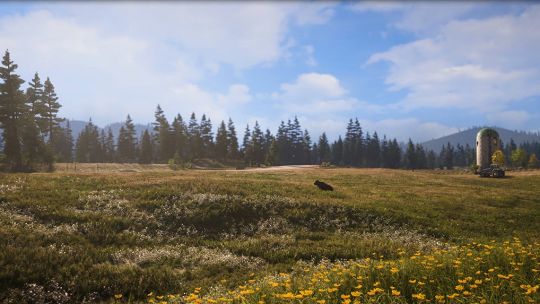
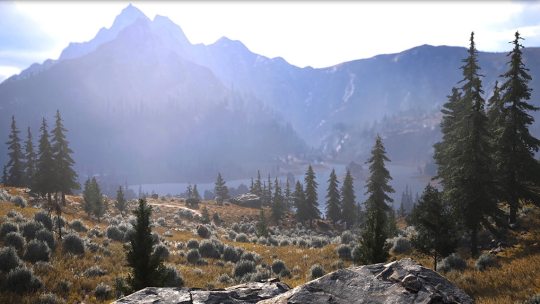
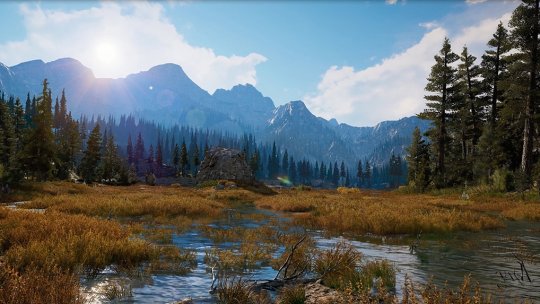
Small and barely visible white eagle with a transparent background below.

Small and barely visible white eagle with a transparent background above.






#far cry 5#eden’s gate#hope county#joseph seed#holland valley#john seed#henbane river#faith seed#whitetail mountains#jacob seed#grace armstrong#nick rye#boomer
33 notes
·
View notes
Note
Hello!
I've been devoted to Apollo for some time now, but I haven't been able to find sources that can clearly explain to me his festivals/holidays and how to celebrate them.
I'm coming from Wicca (as that's all I was exposed to in terms of spirituality, previously), but I feel that its never worked for me. Hellenism seems like a nicer fit, as I'm already interested in the history of the time and I feel connected to the Theoi (especially Apollo) already.
As I'm finding myself in my spiritual journey and figuring things out, I do feel that slowly transitioning (maybe one deity at a time) will be for the best; especially since I'm still young and don't have all the time in the world.
Anyway ! To get to the point (I'm sorry for being all over the place), I was previously celebrating the Wiccan wheel of the year in a more Apollo-centric way, but I would like help finding information on His real festivals and holidays.
I'm sorry if you've gotten a similar ask, or if you've talked about this already! Thank you for this blog, its helped me a lot !!
Hi there!
I was planning to make a post about his festivals anyway, so here we go!
Apollo's festivals
We probably have the most detailed accounts of Attic/Athenian and Panhellenic festivals when it comes to most gods. Of course, other festivals such as regional ones did exist and I could mention some of them and the scarce bits and pieces of information that have survived but in this post I will focus on festivals and celebrations we know a little more about - some of the ones we could celebrate nowadays or even attempt to reconstruct. There were plenty of festivals celebrating different gods and Apollo had quite a few of his own but I think this will be more useful in terms of modern religion.
I will briefly talk about the history, how the festivals were celebrated back in ancient times and what we could do nowadays. Don't stress if you don't have access to some of the things listed as offerings. These are only my suggestions and things that could especially be associated with each festival. It's fine to offer something else.
So, let's go over some main festivals of Apollo:
Just a PSA: you don't have to celebrate all of them
Pythian Games - Panhellenic; every four years - during the third year of each Olympiad
History: The games were said to have been established shortly after Apollo killed Python and set up the oracle at Delphi. They were also meant to commemrate those events.
Celebration: involved various athletic (foot & chariot races) and musical competitions. The winners received a wreath of bay laurels from the city of Tempe in Thessaly.
What could we do nowadays: Offerings - wine, oilve oil, laurel; watch sport/musical competitions on the TV or attend an event like that; physical activity, listen to music, sing, write songs/poetry
Pyanopsia/Pyanepsia - Athenian; 7th day of Pyanopsion (around October)
Gods: Apollo, Helios, Horai
History: The origins of the festival are linked to the Athenian hero Theseus was said to have established the celebration to thank Apollo and commemorate his victory over the Minotaur.
Celebration: Rites incorporated remnants of rustic magic, including two offerings, consisting of a hodgepodge of the pulse (edible seeds) and a branch of olive or laurel bound with wool, around which were hung fruits of the season, pastries, and small jars of honey, oil, and wine. The offerings were carried to the Temple of Apollo, where they were suspended on the gate. The doors of private houses were similarly adorned. Children carried Eiresione [Ειρεσιώνη] - a wand of laurel. They were going from house to house singing. It's possible that in exchange for Eiresione, the children received small gifts. Eiresione was said to bring good luck over the year if fixed above the door.
What could we do nowadays: Offerings - especially seeds from the legume family, grains, honey, wine, olive oil, fruit, incense, laurel & olive branches/leaves; singing, celebrating with your loved ones (if you can), prayer/hymns, exchanging small gifts, hanging a laurel/olive branch over the door
Delphinia - Athenian; also celebrated in various other parts of Greece; 6th Mounychion (around April)
Gods: Apollo & Artemis
History: Again, connected to Theseus
Celebration: involved a procession to the Delphinion (the shrine) where both Apollo and Artemis were worshipped. Seven boys and seven girls carried olive branches, bound with white wool. There's a possibility Apollo was also honoured as a god having influence on the sea.
What could we do nowadays: Offerings - especially olive oil, olive branches/leaves, water, saltwater, wine, incense; going on a walk - especially somewhere by the sea or a river; prayer/hymns
Gynmopedia - Spartan; annual (around the 6th to the 10th of July)
Gods: Apollo, Artemis & Leto
History: might've begun in 668 BCE to honour a Spartan victory in Thyrea. Apparently, it's possible that Lacedaemonians took it "more seriously than any other festival". It was the first public gathering of the new year.
Celebration: it featured enerations of naked Spartan men participating in war dancing and choral singing, basically it was an exhibition of all kinds of accomplishments in gymnastics, music, and dancing. They would honour Apollo through songs and performed songs which represented the phases of life. The leader of each chorus group would wear a headpiece known as the "feather crown" made of palm leaves.
What could we do nowadays: Offerings - palm leaves; dance, singing, blasting music, physical activity, celebrate with your loved ones (if you can), reflect on life a bit
Hyacinthia - Spartan (+Amyclae); three-day & annual (probably early summer)
Gods: Apollo & Hyacinthus
History: Based on mythology. Held in honour of the Spartan youth, Hyacinthus who was a lover of Apollo.
Celebration: Athletic contests were held to commemorate Hyacinthus' death (killed with a miscast discus). The rites gradually passed from mourning for Hyacinthus to rejoicing in the majesty of Apollo. It's probable the festival was connected with vegetation and might've marked the passage between spring and summer.
What could we do nowadays: Offerings - flowers, incense, grains; physical activity, prayer/hymns, take some time to appreciate the people in your life, read the myth about Hyacinthus
Karneia - Spartan, 7th (Attic) Metageitnion/(Spartan) Karneios (around August)
Gods: Apollo (Karneios)
History: Due to the sacred law, the festival was the reason why Spartans did not help the Athenians in the Marathon battle.
Celebration: Five young men were chosen out of each tribe; one man, decked with garlands, ran away, and the rest followed him. The festival might've been connected to vegetation and fertility.
What could we do nowadays: Offerings - flowers, grains, fruit; prayer/hymns, physical acrivity (go for a jog/play tag?), spend some time outside, learn about the Battle of Marathon
Thargelia - Athenian; (pretty important festival), annual 6th & 7th of Thargelion (around May)
Gods: Artemis & Apollo
History: held on birthdays of Artemis & Apollo; sometimes it might've involved human sacrifice, especially in it's early days
Celebration: vegetation ritual; It was common to offerthe first-fruits of the earth to the gods. The first day involved a purifying and expiatory ceremony. On the second day of the festival there was a feast and procession as a mark of thanksgiving. Branches of olive bound with wool, borne by children, were affixed by them to the doors of the houses (pretty much the same thing as during Pyanopsia). Musical contests were also common on the second day.
What could we do nowadays: Offerings - grains, bread, honey cakes, all kinds of fruit (especially figs), honey, wine, olive oil, incense, olive branches/leaves; prayer/hymns, plan a purification ritual/activity (it could even involve things like: cleaning your house, taking a bath, etc.), make dinner and invite friends/loved ones to share it with, sing and listen to music.
Apollo is also honoured during:
Noumenia (new moon) under his epithet Noumenios
The 7th day of each month
During Summer/Winter Solistice (his arrival from/deparure to Hyperborea, marking the change in seasons, if you follow the myth)
Some things that might also be useful:
Here's an example of "Greek Wheel of The Year":

It's a simplified diagram showing some main Hellenic holidays. You can find more info on the website (link above). Of course, this is not the only way to celebrate Hellenic festivals but since you mentioned the Wiccan Wheel of The Year, I figured it could be easier to picture or get used to.
Attic Callendar 2022 - a reconstruction of the Attic (lunar) calendar; days marked for specific festivals and to honour certain deities [FYI Hellenion is kinda problematic, though, so keep that in mind - see more about that here & here ]
Ancient Greek Fesivals - summaries
You can also create a personal, UPG-based festival/holiday! @theoi-crow explains it really well in this post - LINK
I might write a short post about other fesivals for/involving Apollo, such as Stepterion because I think it's particulary interesting but could be difficult to celebrate today. It's more of a bonus, so I'll just link it here once I'm done.
Hope this will be helpful!
#asks#apollo#apollo deity#apollo festivals#apollo devotee#apollo devotion#apollo worship#apollon#apollodeity#apollon deity#helpol#hellenic polytheism#hellenic gods#hellenic deities#hellenic pagan#hellenic holidays#hellenic festivals#hellenic paganism#theoi
652 notes
·
View notes
Text
Stuart Banham Follow
Gloster Meteor F.Mk.8 (WK654) Jet Fighter, City of Norwich Aviation Museum.
This aircraft is painted the colours of 245 Squadron based at RAF Horsham St Faith. The museum acquired the aeroplane from RAF Neatishead were it was displayed at a 'gate guard' for many years. Much of the repainting was carried out by painters from RAF Coltishall in the summer of 2005.
The RAF's main Fighter from 1950 to 1955, was the Gloster Meteor, this was Britain's first Jet Fighter, the Mk.I's were the only Allied Jet Aircraft to see operational service during World War Two, they equipped No.1 Squadron which went into action in 1944 against the German V1 Flying Bombs fired against Great Britain. The Squadron had some success but found the Meteor could not accelerate as quickly as the RAF's latest large piston engined Fighters !
Improved versions of the Meteor followed in the Post War years, the Meteor F8 entered RAF service in 1950 replacing the earlier F4's as the 'mainstay' of Fighter Command’s Home Defence Squadrons.
The Gloster Meteor was the first British Jet fighter and the Allies' only Jet Aircraft to achieve Combat Operations during World War Two. The Meteor's development was heavily reliant on its ground-breaking 'Turbojet Engines' pioneered by Frank Whittle and his company ''Power Jets Ltd''. Development of the Aircraft began in 1940, although work on the Engines had been under way since 1936. The Meteor first flew in 1943 and commenced operations on 27th July 1944 with No.616 Squadron RAF. The type was not a sophisticated Aircraft in its aerodynamics, but proved to be a successful Combat Fighter. Gloster's 1946 civil Meteor F.4 demonstrator G-AIDC was the first civilian-registered Jet Aircraft in the world. Several major variants of the Meteor incorporated technological advances during the 1940's and 1950's. Thousands of Meteors were built to fly with the RAF and other Air Forces and remained in use for several decades.
Gloster Meteors of the Royal Australian Air Force (RAAF) fought in the Korean War, several other operators such as Argentina, Egypt and Israel flew Meteor's in later regional conflicts. Specialised variants of the Meteor were developed for use in Photographic Aerial Reconnaissance and as Night Fighters. The Meteor was also used for research and development purposes and to break several aviation records and on 7th November 1945, the first official airspeed record by a Jet Aircraft was set by a Meteor F.3 at 606mph. In 1946, this record was broken when a Meteor F.4 reached a speed of 616mph. Other performance related records were broken in categories including flight time endurance, rate of climb, and speed. On 20th September 1945, a heavily modified Meteor Mk.I powered by two Rolls-Royce Trent Turbine Engines driving propellers, became the first turboprop aircraft to fly. On 10th February 1954, a specially adapted Meteor F.8, the ''Meteor Prone Pilot'' which placed the Pilot into a prone position to counteract inertial forces, took its first flight.
In the 1950's, the Meteor became increasingly obsolete as more nations introduced Jet Fighters, many of these newcomers having adopted a swept wing instead of the Meteor's conventional straight wing, in RAF service, the Meteor was replaced by newer types such as the Hawker Hunter and Gloster Javelin. As of 2018, two Meteors, G-JSMA and G-JWMA, remain in active service with the Martin-Baker Company as 'Ejection Seat Testbeds'. One further Aircraft in the UK remains airworthy, as does another in Australia.
Late in 1945, two F.3 Meteors were modified for an attempt on the world air speed record, on 7th November 1945 at Herne Bay in Kent, Group Captain Hugh ''Willie'' Wilson set the first official air speed record by a Jet Aircraft of 606mph TAS (True Airspeed) In 1946, Group Captain Edward ''Teddy'' Donaldson broke this record with a speed of 616mph TAS, in EE549, a Meteor F.4.
▪︎Role: Fighter Aircraft
▪︎National Origin: United Kingdom
▪︎Manufacturer: Gloster Aircraft Company
▪︎First Flight: 5th March 1943
▪︎Introduction: 27th July 1944
▪︎Retired: 1980s (RAF Target Tugs)
▪︎Status: Two in use as Testbed Aircraft (one with civil registration)
▪︎Primary Users: Royal Air Force / Royal Australian Air Force / Belgian Air Force / Argentine Air Force
▪︎Power Plant: Rolls-Royce RB.50 Trent
▪︎Produced: 1943 to 1955
▪︎Number Built: 3,947.
Via Flickr
2 notes
·
View notes
